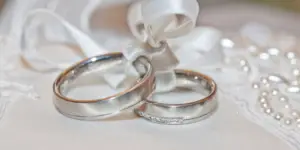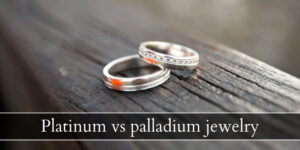When it comes to jewelry there are a few metals that are the go-to materials for nearly everything. Silver is one of them, and so is gold, because for a very long time (read several millennia) these were the only metals to adorn your body with. But as technology advanced, so did out tastes change.
So today we have several options for jewelry metals, including sturdier ones such as stainless steel. Which brings us to today’s key question: what are the main differences between stainless steel and sterling silver ? Is one better than the other in terms of durability ? Can you get equally beautiful jewelry pieces from both metals ?
Take a look at this comprehensive guide on stainless steel vs sterling silver for jewelry, and you’ll easily figure out which metal works best for you, and your preferred jewelry style.

Stainless steel vs sterling silver
Stainless steel is more durable and lightweight than sterling silver, and it’s far more resistant to tarnishing or scratches. Sterling silver is a precious metal and thus more expensive, and comes with the prestige of being a noble metal that is highly sought after for jewelry or decorative items.
Sterling silver is more difficult to clean and keep from turning dark, and as a result has a shorter lifespan than stainless steel before it has to be melted and recast into something new. Stainless steel is not easy to find for jewelry such as rings, earrings, or necklaces since there isn’t enough demand for this, but you can easily find most jewelry in sterling silver.
Important note to those with nickel or copper allergies: sterling silver is made with 92.5 % pure silver and 7.5 % other metals, usually copper. Because of this, sterling silver may leave a green or black stain on your skin, as a result of the copper in its composition. There are sterling silver versions without copper, and you may ask your jeweler what kind they have.
Stainless steel for jewelry is usually surgical or marine steel (316L) and this does not contain any copper, but does contain a small amount of nickel. If you have a nickel allergy then this is not an option for you.
Key differences between sterling silver and stainless steel will be discussed below, and hopefully be enough for you to make an informed decision on what kind of metal to use for your jewelry.
1. Sterling silver may tarnish and scratch in time, stainless steel does not
With daily wear and tear come different occasions for your jewelry to be exposed to the elements. Sterling silver is notorious for tarnishing, and this is simply an unavoidable fact of owning silver jewelry. Tarnishing is just the outer layer of the silver turning into silver sulfide due to contact with oxygen for a prolonged time.
This layer can be easily scrubbed off with a thorough polishing, or a baking soda solution. There’s a reason the phrase’ polishing the silver’ exists, because that’s exactly what you need to do to maintain silver.
Read also: Are Tungsten Rings Good ?
Silver is also a fairly soft metal, even when reinforced with copper or another harder metal. As a result various scratches will accumulate in its surface, leading to a dull appearance.
By contract stainless steel does not tarnish or stain, hence the name. It also does not scratch as easily as silver. Some scratches do accumulate, but they are usually made by much harder materials such as titanium, or diamonds. Stainless steel is meant to last forever and it’s not something that will show a lot of scratches.
2. Stainless steel has a dull grey finish, sterling silver has shiny, brilliant grey
If color is important to you when deciding jewelry, you know both stainless steel and silver will give you a silvery-grey look. However they do so very differently.
Stainless steel looks dull, slightly darker than sterling silver and no amount of polish can get it as bright and brilliant as silver. Meanwhile sterling silver has a nearly-white look to it, and can easily reach a mirror-like polish. That being said, when sterling silver does tarnish it will reveal a warmer tone and lose a lot of its luster, appearing much duller than stainless steel.
3. Sterling silver is a precious metal, comes at a higher price
Gold and silver are very old metals, and they are regarded as noble metals, because they can be safely used in chemistry. So sterling silver has the ‘advantage’ of being well known as a precious metal and as such it will always come at a higher price than stainless steel.
Stainless steel usually has industrial applications, and the one alloy version that is good for jewelry is also good for medical utensils like scalpels or tweezers.
This means that a wedding ring made of sterling silver will be more expensive than a stainless steel one, so if budget is important than stainless steel is a better option.
4. Stainless steel is not as common in jewelry as sterling silver
Despite being cheaper, stainless steel is not as common jewelry as you may think. Most jewelry made of stainless steel is actually piercings or studs.
You can find some rings and earrings made of stainless steel, but they are much rarer than silver. There simply isn’t enough demand for them.
5. Sterling silver can be crafted into delicate pieces, stainless steel is bulky
Because sterling silver is so pliable it can be easily made into very intricate shapes and styles that result in beautiful pieces of art. Jewelry made form sterling silver tends to be very complex and delicate, compared to stainless steel.
Stainless steel may be bent into different shapes, but it cannot be worked into delicate shapes or thin bands, so it usually ends up in bulkier styles that offer a more industrial, geometric, or futuristic look. Perhaps because of this stainless steel is more popular among men than women.
6. Stainless steel is far easier to clean and care for than sterling silver
No tarnish and stain mean easier cleaning and caring, so stainless steel is actually far easier to maintain in its initial form than sterling silver. A simple wash with soap and polish with a soft cloth result in an impeccable finish, just like the day you got your jewelry when it comes to stainless steel.
Sterling silver however requires regular polishing with formula, and an occasional scrub with a soft brush. If you’ve got some very beautiful and intricate engraving in your silver, you’ve got a lot of work to do as those are the most difficult to clean.
7. Sterling silver may bend out of shape or break, stainless steel is more durable
Silver is a softer metal than stainless steel, and as such is can bend out of shape if dropped or in case of an accident. If your piece of jewelry is very delicate or ahs very thin bands then it’s definitely worth treating with a lot more care.
Stainless steel does not bend out of shape, as it’s supposed to be one of the toughest metal alloys possible. So if you find yourself working in a very harsh environment or operating heavy machinery, lifting heavy things, stainless steel will retain its shape, not stain, and not scratch.
Can I wear sterling silver or stainless steel in the shower ?
You can wear stainless steel in the pool, the seal, or shower with it, but not with sterling silver. Repeated exposure to seawater, water, or chlorine will make sterling silver tarnish much faster than usual. Stainless steel is meant to be highly resistant to this.
So what is the verdict ? Sterling silver is more delicate and more beautiful than stainless steel, but it needs a lot of upkeep and requires you to handle it with more care. Stainless steel is much more affordable and does not really mind what you subject it to.

I’m the main author for jewelrymaterialguide.com. I started this site after we did tons of research before our wedding and noticed that there is information about rings, jewelry, and so on that is really hard to find on the internet.






